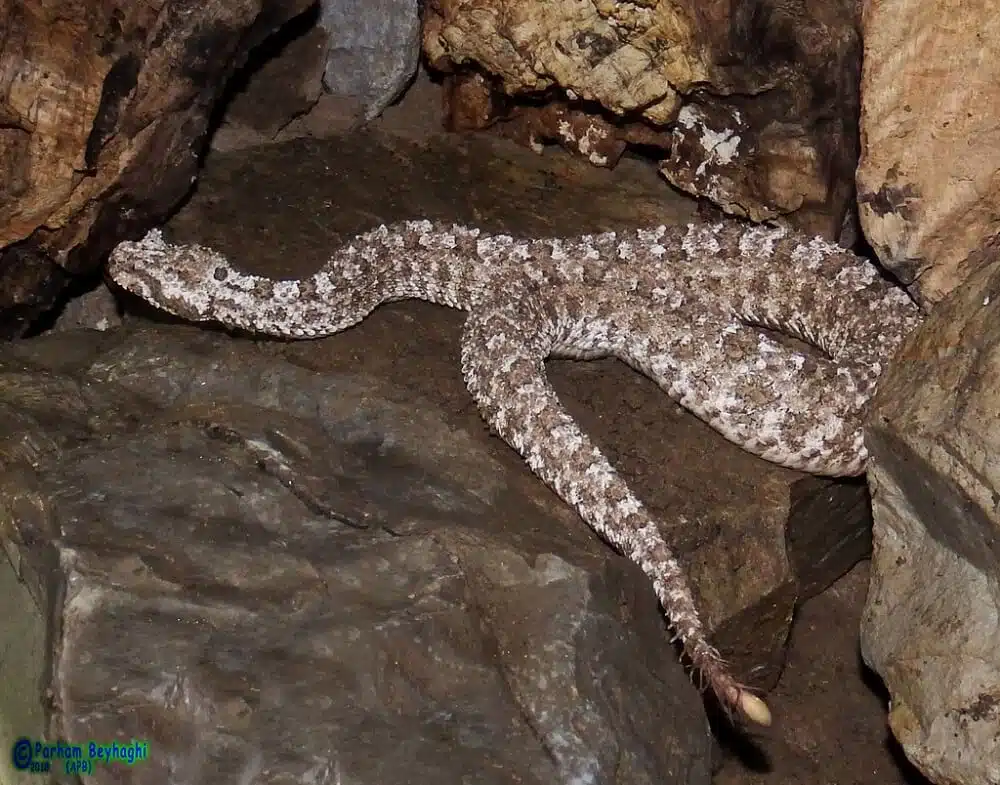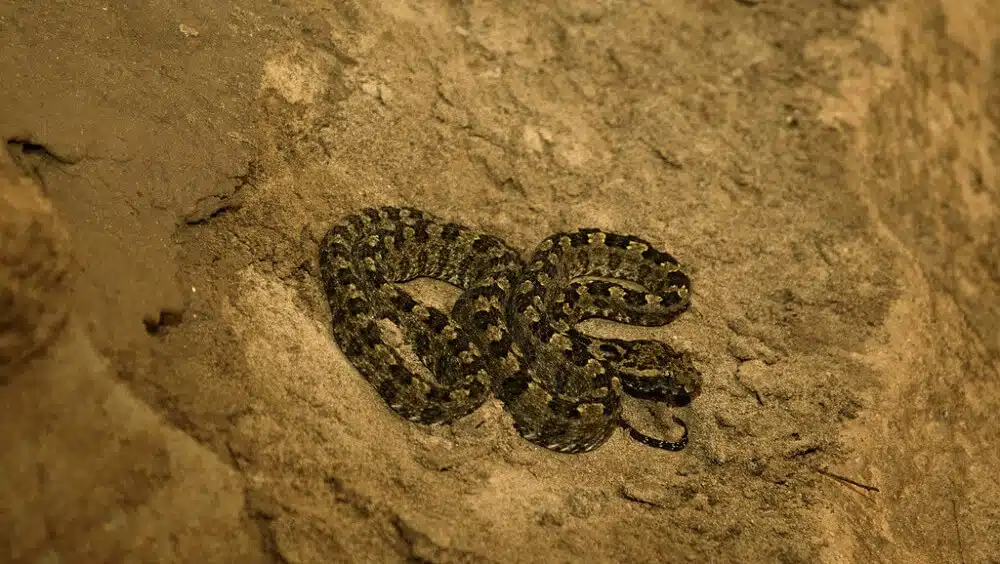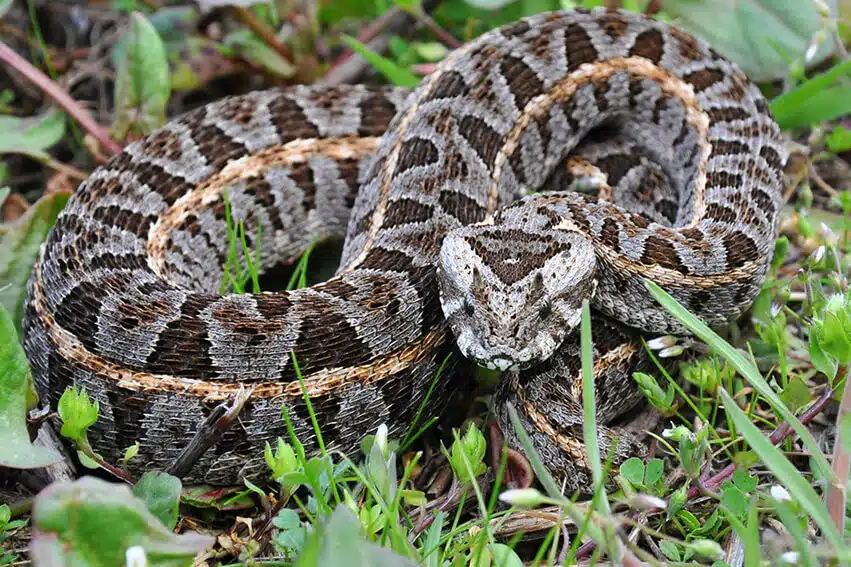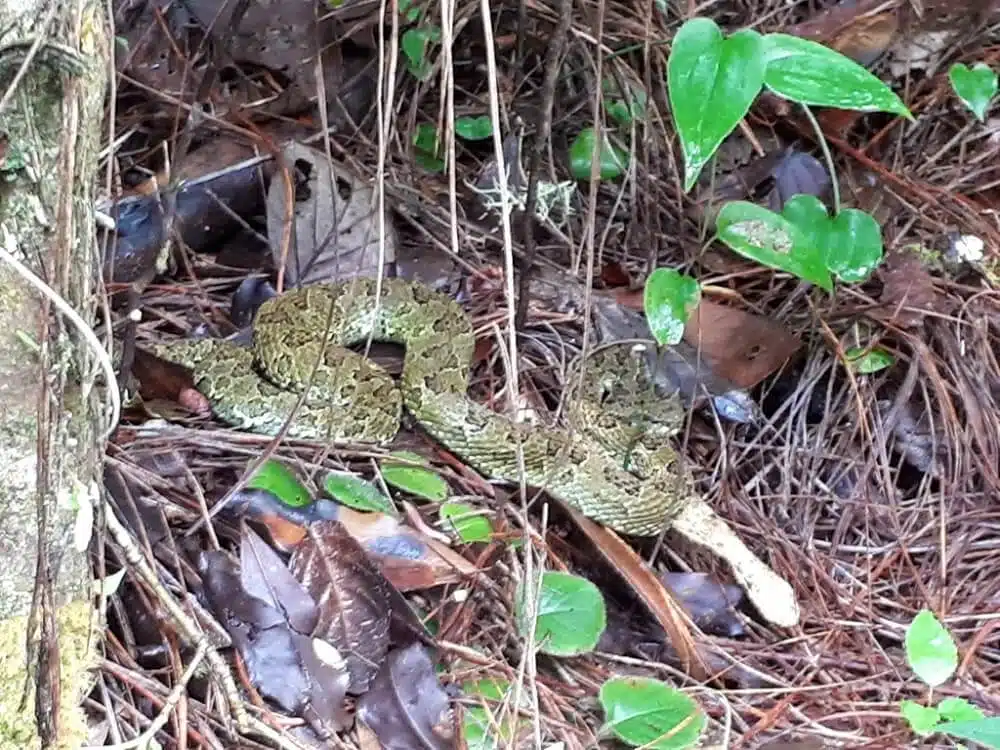Several snakes have horns. If you have recently seen a snake and you think it had horns or what looked like horns, then continue reading to find out more.
Table of Contents
Why do Some Snakes Have Horns
The small horns that are found on the head of some snakes help the snakes with camouflage. This suggests that the snakes have evolved due to their varying environments.
It is believed that the horns, which are scales, protect the eyes from sand and sun. The horns are soft and are made from scales or spikes. The majority of snakes with horns come from the same group, Viperidae.
Those that dwell in desert habitats may have horns to protect against the harsh sun and sand. When the snake is submerged in the sand, the horns bend down, protecting the eyes.
Snakes do not have eyelids with many having a transparent scale that covers the eye. The horns help to keep sand grains away from the eyes when the snake lies on sandy surfaces.
Many suggest that the horns protect by deflecting vegetation from the eyes when the snakes move through the undergrowth. It is also possible the horns could be used as a display or signal.
21 Snakes With Horns
The twenty-one snakes with horns include:
1. Spider-tailed Horned Viper

The Spider-tailed Horned Viper (Pseudocerastes urarachnoides) is a venomous snake belonging to the Viperidae family, known as false-horned vipers. They are endemic to western Iran and Iraq. They were first described in 2006.
This viper has a unique tail that is bulb-shaped with long drooping scales, making the tail look like a spider. The tip of the tail is used to lure birds, bringing them within striking range.
The scales above the eyes give this snake horns. It has rough scales covering the body. It is an excellent mimic and the tail resembles a spider, which is excellent at attracting insectivorous birds.
2. Many-Horned Adder

The Many-Horned Adder (Bitis cornuta) is a viper species found in rocky desert areas on the Atlantic coast of South Africa and southwestern Namibia. It has horns above each eye. It is a venomous snake with no subspecies.
This small snake grows to fifty centimeters in length with two to five raised scales above each eye, which form horns. The snake is gray to red-brown and has four large dark brown patches edged in white.
The belly is tan or white with dark brown specks. The snake is common in rocky desert areas and mountain slopes. It is a very nervous snake if disturbed and will hiss and strike using most of its body, which is lifted off the ground.
They are common in captivity and do settle down over time.
3. Leaf-Nosed Snake

The Leaf-Nosed Snake (Langaha madagascariensis) is medium-sized and endemic to Madagascar. It is found in dry forests and rainforests. They can grow to one meter in length.
Males are brown with yellow bellies and females are gray with flattened snouts. This is a sit-and-wait predator and hangs straight down from a branch. They prey on lizards. It exhibits hooding when it stalks its prey.
The hooding and swaying behavior, along with its color patterns, is believed to help the snake mimic a vine that sways in the wind. This is a calm snake and seldom bites. If they do bite, the bite is exceptionally painful but not deadly.
4. Horned Puff Adder

The Horned Puff Adder (Bitis caudalis) is a viper snake and is found in southwest Africa, South Africa, Angola, Botswana, Zimbabwe, and Namibia. It has a large horn over each eye and is highly venomous.
This short snake grows to forty centimeters in length, including the tail. They prefer sparsely vegetated deserts and semiarid scrub areas.
Bites are very rare. It would take three hundred milligrams of the horned puff adder venom to kill an adult human. This is one of the weakest venoms in this genus. Symptoms associated with bites from this species include pain, vomiting, shock, nausea, and swelling. The bite site develops blisters and ulcers.
There is an antivenom for horned puff adder bites and it is very effective.
5. Nose-Horned Viper

The Nose-Horned Viper (Vipera ammodytes), also known as the horned viper, is a venomous snake from southern Europe. It is mainly encountered in northern Italy, the Balkans, and parts of Asia. It is considered one of the most dangerous European vipers.
It is large with long fans and highly toxic venom. The snake can grow to fifty centimeters with the maximum length based on location. Those in the northern areas are larger than those encountered in the south.
The head has irregular small scales that can be weakly keeled or smooth. Large scales extend beyond the posterior margin of the eye, which are the horns. There is a single horn on the snout, just above the nostril scale.
The horn comprises up to seventeen smaller scales, arranged in two rows. The horn is soft and flexible and can grow to five millimeters. The body is strongly keeled.
The nose-horned viper varies in color with males having irregular dark markings on the head and a black stripe that runs from the back of the eye to the jaw. There is a V on the back of the head connected to a zigzag dorsal pattern. The ground color is gray.
Females have a similar color pattern. They do not have the V on the back of the head and the females’ ground color can range from brown to red-brown. Both males and females have the dorsal zigzag stripe on a light background.
This is a strictly protected snake species. Commonly found in rocky hillsides where there is sparse vegetation. They do make their way into human habitation areas. It is a lethargic snake and not aggressive. Bites are very rare and they only bite when they are threatened.
Their reaction to being disturbed will vary with some remaining sill and hissing, while others will flee, and some will try and bite immediately.
6. Three Horned-scaled Pitviper

The Three Horned-scaled Pitviper (Protobothrops sieversorum) is a venomous viper snake endemic to Vietnam. It belongs to the Viperidae family. It is endangered by IUCN.
As pit vipers, they have heat-sensing pits just under the eyes. They can be encountered in a range of habitats including scrub, forested areas, and dry flatlands. They are popular in captivity and can live up to fifteen years.
7. Saharan Horned Viper

The Saharan Horned Viper (Cerastes cerastes) is a North African desert snake that is only sixty centimeters in length. This is a venomous snake with a flat, broad head and a thin neck.
This is a heavily-keeled snake with horns that is a single scale above each eye. There is a dark line that runs from the horns to the back of the snake. They have broad, flat bodies and a black tip on the end of the tail.
The Saharan horned viper is brown-yellow and gray, which helps it blend into its sandy environment. There are brown patches on the belly. They are commonly found in Iraq but can also be encountered in Jordan, Israel, Kuwait, Saudi Arabia, Syria, and Yemen.
They prefer dry and sandy areas with little rocks. They avoid coarse sand. They leave an entire body impression as they move through the sand. Even though they are venomous they tend to be placid. They will assume a C-shaped posture and rub their coils together if they feel threatened. The rubbing causes a rasping noise.
They are ambush predators and will lie in the sand and wait for prey to pass. They can strike very quickly and hold onto the prey until their venom takes effect.
8. Persian Horned Viper

The Persian Horned Viper (Pseudocerastes persicus) is a venomous viper from the Middle East and Asia. They can grow to seventy centimeters in length with females being larger than males. They are very heavy snakes with broad, flat heads.
The snout is rounded and short with unbroken nasal scales. The horns, one above each eye, are also found in juveniles. They are weakly or strongly keeled. They are common in sandy or limestone rock deserts with some vegetation. They avoid human habitation.
This is a slow-moving snake and is mostly nocturnal. They are not very aggressive but they will hiss very loudly if you disturb them.
9. Horned Rattlesnake

The Horned Rattlesnake (Crotalus cerastes) is also known as the sidewinder. It is a pit viper and is found in the desert areas of the Southwestern United States and northwestern Mexico. It is a venomous snake that is small in size, growing to seventy-six centimeters in length.
It has raised supraocular scales above the eyes, forming horns. It is believed the horns help the snake as it drifts over the sand and lies almost buried. They are cream, yellow-brown, pink, or ash-gray with patches. The belly is white with a brown rattle.
This is a nocturnal snake in warmer months and comes out during the day in cooler months. As Juveniles, they use their tails to attract lizards. As adults, they feed mostly on other snakes, rodents, and birds.
10. Broad-Borned Pitviper

The Broad-Borned Pitviper (Ophryacus sphenophrys) is a venomous snake endemic to eastern Mexico. It does not have a rattle and the head is wide with a pointed snout. They have bright yellow bodies with black stripes. There are forty dark patches outlined in black.
The head is bright yellow with black stripes. There is an M-shape on the back of the head. The belly is yellow with small black spots. They are common in humid pine-oak woodlands, pine forests, and cloud forests.
11. Kenya Horned Viper

The Kenya Horned Viper (Bitis worthingtoni) is a venomous snake in the Viperidae family and endemic to Kenya. They can grow to forty centimeters in length, which includes the tail.
They prefer grasslands, savannas, shrublands, and rocky areas. They are listed as vulnerable due to their limited geographic range, demand by reptile collectors, and habitat loss.
12. Fi-si-pan Horned Pit Viper

This Horned Pit Viper (Protobothrops cornutus) is venomous and is found in northern and central Vietnam and southern China. It is commonly found in evergreen forests. They are considered near threatened.
This snake is brown with dark brown patches surrounded by black edges. Its triangular-shaped head has two horns, one above each eye. The belly is light brown to tan with patches. They are very common as reptilian pets with many private keepers having great success in breeding this species.
This is a small snake, semi-arboreal, and only grows to seventy centimeters. They are very agile. They are nocturnal and are ambush predators. They go into a defensive position when they are disturbed and very reactive to any movement or touch.
13. Butterfly Viper

Butterfly Vipers (Bitis nasicornis) are found in West and Central Africa in forested areas. They are large vipers with striking coloration and prominent nasal horns. They grow to one hundred and seven centimeters in length with females being larger than males.
They have a flat and narrow head with two to three horn-like scales on the end of the nose. They have rough-keeled scales which are known to cut their handles when they struggle.
They have up to eighteen blue-to-blue-green markings with a yellow line down the center. These have an irregular black patch. Dark red triangles run down the flanks, bordered by blue or green.
This nocturnal snake can camouflage into their habitat, making them almost invisible. They are mainly terrestrial and are often found up to three meters above the ground. They are also very powerful swimmers.
14. Mexican Horned Pit Viper

This Mexican Horned Pit Viper (Ophryacus undulatus) is found in the mountainous areas of central and southern Mexico. They grow to seventy centimeters in length and are stout. They have horns over the eyes.
This snake is silver-gray with black patches that form a wide wavy stripe. They have black on the top of the head. They are commonly found in rock and brush slopes close to streams.
They are classed as vulnerable on the IUCN Red List of Threatened Species. They are active during the day and are often seen coiled near fallen logs and in bushes.
15. Field’s Horned Viper

The Field’s Horned Viper (Pseudocerastes fieldi) is endemic to the Middle East desert areas. They are venomous and are considered a subspecies of the Persian horned viper. It has a neurotoxic venom with no antivenom available.
They are rough-scaled snakes that blend into the sand with gorgeous coloration and large horns. They are popular pets for reptile enthusiasts and can live more than eighteen years in captivity.
16. Emerald Horned Pitviper

The Emerald Horned Pitviper (Ophryacus smaragdinus) is a venomous snake endemic to Mexico. This large species can grow to seventy centimeters in length with a single scale over the eye to form a horn. They are restricted to the mountains of central, southern, and eastern Mexico.
The snake was only recently discovered in Mexico and was named the emerald horned pitviper for its beatitude green coloration and the two horns above the eyes. It is known as torito by locals, which means bull in Spanish.
17. Black-tailed Horned Pit Viper

The Black-tailed Horned Pit Viper (Mixcoatlus melanurus) is a venomous snake endemic to the mountain areas of southern Mexico. As adults, they can grow to fifty centimeters and are stout. They are listed on the endangered list of the IUCN Red List of Threatened species.
This terrestrial species can grow to fifty centimeters in length, including the tail. They are brown to ash in color and can be encountered in the high and tropical scrub, deciduous forests, and pine-oak forests in southern Mexico.
18. Lataste’s Viper

The Lataste’s Viper (Vipera latastei) is also known as the snub-nose viper and is a venomous snake in the Viperidae family. They are found in the Iberian Peninsula and northwestern Maghreb. This snake can grow to seventy-two centimeters in length.
They are gray with triangular-shaped heads. There is a horn on the tip of the nose. They have a yellow tail tip and a zigzag pattern that runs down the back. They are encountered during the day and night hiding under rocks.
This snake prefers moist and rocky areas, often seen in woodlands, coastal dunes, and dry scrublands.
19. Tentacle Snake

The Tentacle Snake (Erpeton tentaculatum) is a rear-fanged aquatic snake that is native to Southeastern Asia. It has two tentacles on the snout, a very unique feature in snakes.
This small snake can grow to ninety centimeters in length and have two color phases. They can be striped or blotched. Both phases go from brown or dark gray to light tan. They live in murky waters.
This is a venomous snake, but they are not dangerous to humans. They have small fangs that are far back in the mouth. The venom is specific for fish. The snake spends its entire life in the water and can remain below the water for thirty minutes.
They can move on land where they will bury themselves in mud when the water dries up.
20. West African Gaboon Viper

The West African Gaboon Viper (Bitis rhinoceros) is venomous and endemic to West Africa. It has two large nasal horns. There is a dark triangular marking from the back of the eye to the mouth.
This snake arises from brown to purple with a symmetrical pattern on the body that looks like yellow hourglasses. They feed mostly on rodents, birds, toads, frogs, and small mammals.
21. Arabian Horned Viper

The Arabian Horned Viper (Cerastes gasperettii) is a venomous viper that is found in the Arabian peninsula, Iran, and Iraq. They can grow to sixty centimeters with the female being larger than the male.
They feed mostly on rodents, beetles, and lizards. They have flat heads that are triangular and covered in keeled scales. The body is stocky.
They have large outward-facing horns from above the eye. They are sandy-colored helping them blend in with their surroundings when buried in the sand.